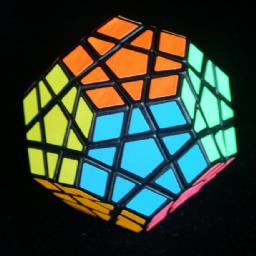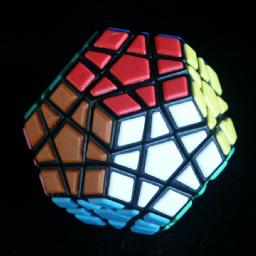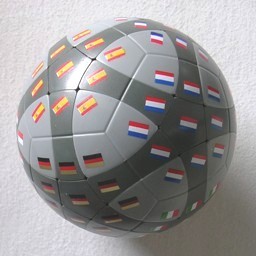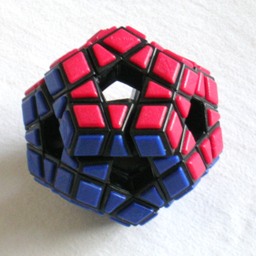









This is a variant of the Rubik's cube, in the shape of a dodecahedron. It is a very logical progression from the cube to the dodecahedron, as can be seen from the fact that the mechanism is virtually the same, and that many people invented it simultaneously. To quote from Cubic Circular, Issue 3&4, (David Singmaster, Spring&Summer 1982):
"The Magic Dodecahedron has been contemplated for some time. So far I have seen photos or models from: Ben Halpern (USA), Boris Horvat (Yugoslavia), Barry Lockwood (UK) and Miklós Kristóf (Hungary), while Kersten Meier (Germany) sent plans in early 1981. I have heard that Christoph Bandelow and Doctor Moll (Germany) have patents and that Mario Ouellette and Luc Robillard (Canada) have both found mechanisms. The Hungarian version is notable as being in production ... and as having planes closer to the centre so each face has a star pattern."
"Uwe Mèffert has bought the Halpern and Meier rights, which were both filed on the same day about a month before Kristóf. However there is an unresolved dispute over the extent of overlap in designs."
There are several versions that have been made.
The standard megaminx has either 6 colours or 12 colours. The face layers are
fairly thin, so the edge pieces have some width to them.
A version called the Supernova was made in Hungary, and it has 12 colours and
thicker face layers which meet exactly at the middle of an edge.
The Ball.B is a spherical of this puzzle. The version with flags on the faces has the
extra complication that the orientation of the centres are visible, making it more difficult.
The Holey Megaminx is a version without face centres, inspired by the Void Cube.
Related puzzles are Alexander's Star, which is equivalent to a megaminx without corners or centres, and the Impossiball, which is equivalent to a megaminx without edges or centres.
There are 30 edge pieces with 2 orientations each, and 20 corner pieces with 3 orientations, giving a maximum of 30!·20!·230·320 positions. This limit is not reached because:
This leaves 30!·20!·227·319 = 100,669,616,553,523,347,122,516,032,313,645,505,168,688,116,411,019,768,627,200,000,000,000 or 1.0·1068 positions.
If only 6 colours are used, giving 15 pairs of indistinguishable pieces, then this number has to be divided by 214 (not 215 since only an even number of swaps are possible) which gives 6,144,385,775,971,883,979,645,753,925,393,402,415,081,061,792,664,780,800,000,000,000 or 6.1·1063 positions. Despite these huge numbers, the puzzle is no harder than the Rubik's cube.
If the face centres have visible orientations, then the number of positions is multiplied by a factor 512 because each of the 12 centres can be twisted independently. A super-megaminx with 12 colours therefore has 30!·20!·227·319·512 = 24,577,543,103,887,535,918,583,015,701,573,609,660,324,247,170,659,123,200,000,000,000,000,000,000,000 or about 2.5·1076 positions.
 Let U, R, F be three adjacent faces (Up, Right and Front), in other
words, U, R, F are faces arranged clockwise around a vertex. Let D be the
other face adjacent to both F and R. Clockwise 1/5 twists of a face are
denoted by the appropriate letter, anti-clockwise 1/5 twists by U', R', F' or D'.
In the solution below, the D face is usually still unsolved. We can denote
the locations of the edge pieces by using two letters, for example UF is the
edge location that lies in both the U and F faces. Similarly, corner locations
are denoted by three letters as they lie in three faces.
Let U, R, F be three adjacent faces (Up, Right and Front), in other
words, U, R, F are faces arranged clockwise around a vertex. Let D be the
other face adjacent to both F and R. Clockwise 1/5 twists of a face are
denoted by the appropriate letter, anti-clockwise 1/5 twists by U', R', F' or D'.
In the solution below, the D face is usually still unsolved. We can denote
the locations of the edge pieces by using two letters, for example UF is the
edge location that lies in both the U and F faces. Similarly, corner locations
are denoted by three letters as they lie in three faces.
If you can solve the top and middle layer of the Rubik's cube, then you can use the same techniques on the megaminx to solve everything but the final layer.
Phase 1: Solve all but final face
In the phases below, we need to have names for all the faces adjacent to the D face in order to describe all the possible pieces on the D face. Lets call these faces in clockwise order: L, F, R, b, B.
Phase 2: Orient the edges of the final face.
The edges are flipped in pairs. It is impossible to have only one edge
upside down.
Phase 3: Position the edges of the final face.
Phase 4: Position the final corners.
Phase 5: Orient the final corners.
Phase 6: Orient the centres (for some types of megaminx only).